Principles of Management and Leadership in Organisations Report
VerifiedAdded on 2023/01/23
|14
|3124
|42
Report
AI Summary
This report delves into the principles of management and leadership within organizations, covering various aspects such as different levels of leadership, including assigned versus emergent leadership, and the importance of responsibility and accountability. It examines the relationship between organizational vision, values, and goals and how they influence leadership effectiveness. The report further explores leader skills, behaviors, and attitudes, analyzing different leadership models and styles, and the practices of effective leaders and managers. It also discusses the significance of delegation, empowerment, and the impact of organizational structure, culture, and climate on managerial effectiveness. The final section focuses on performance management, including the tools used within organizations, such as key performance indicators, performance appraisals, management by objectives, and 360-degree feedback, as well as the roles of coaching and mentoring, and the role of effective communication in achieving organizational goals.
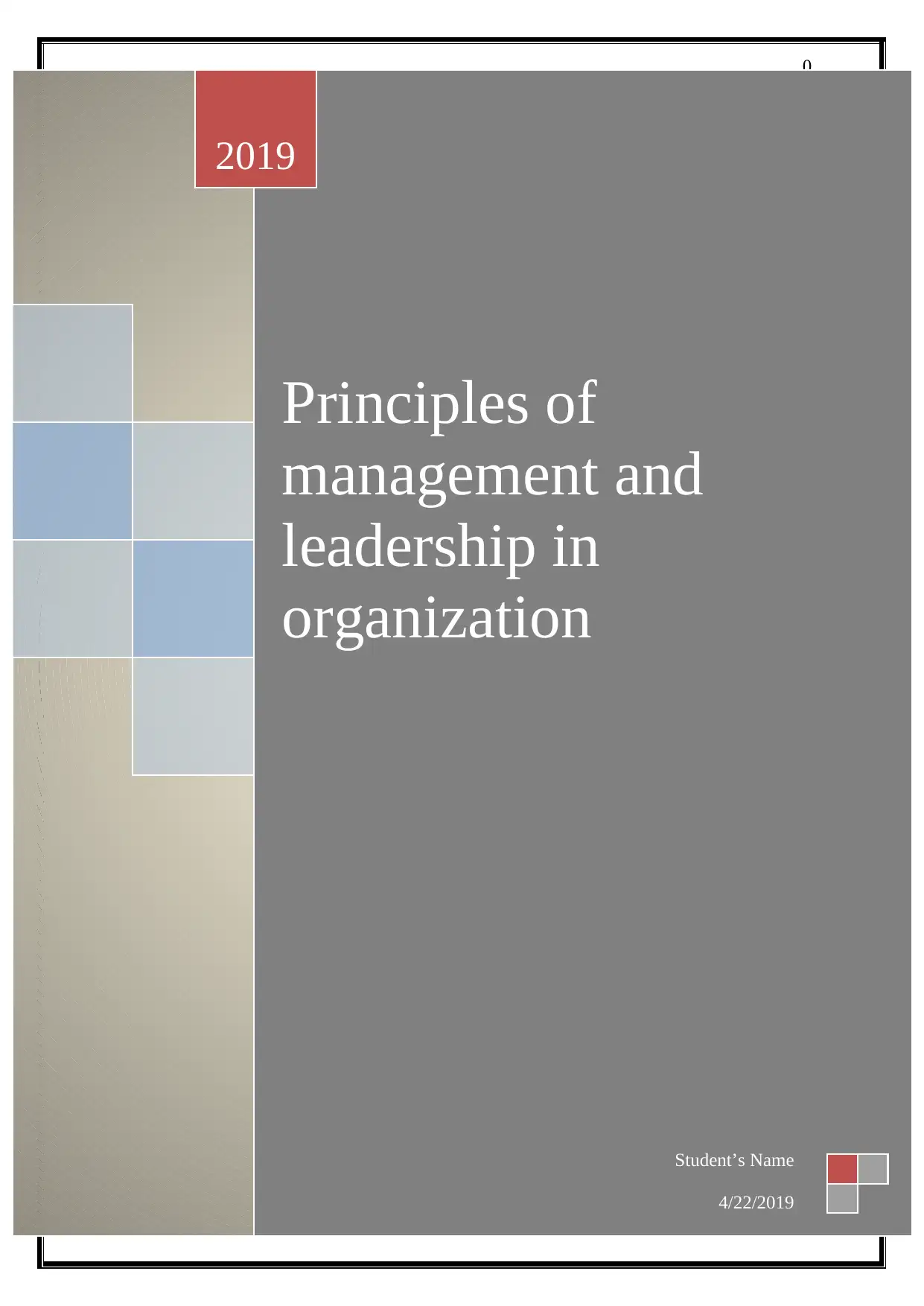
0
Principles of
management and
leadership in
organization
2019
Student’s Name
4/22/2019
Principles of
management and
leadership in
organization
2019
Student’s Name
4/22/2019
Paraphrase This Document
Need a fresh take? Get an instant paraphrase of this document with our AI Paraphraser
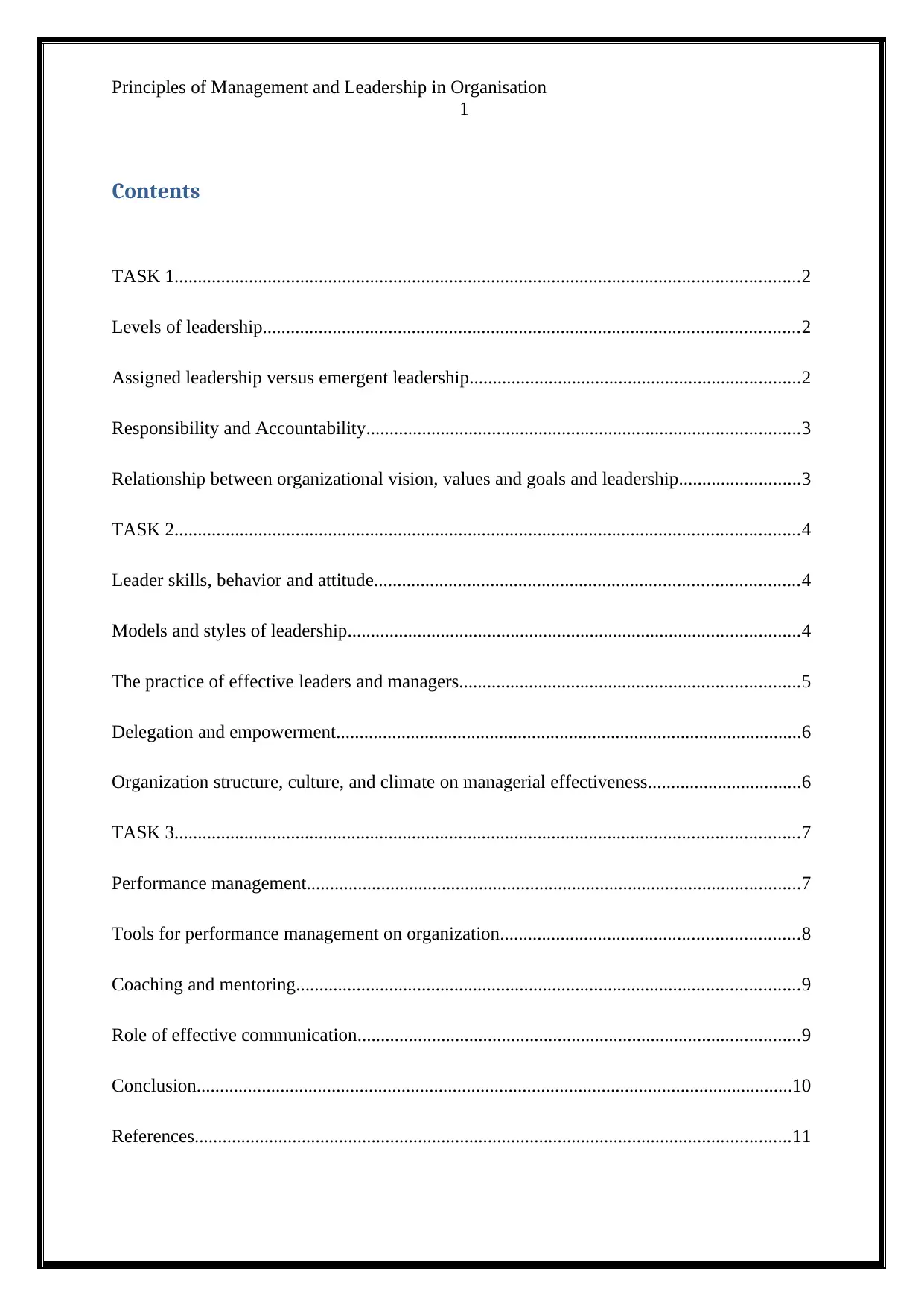
Principles of Management and Leadership in Organisation
1
Contents
TASK 1......................................................................................................................................2
Levels of leadership...................................................................................................................2
Assigned leadership versus emergent leadership.......................................................................2
Responsibility and Accountability.............................................................................................3
Relationship between organizational vision, values and goals and leadership..........................3
TASK 2......................................................................................................................................4
Leader skills, behavior and attitude...........................................................................................4
Models and styles of leadership.................................................................................................4
The practice of effective leaders and managers.........................................................................5
Delegation and empowerment....................................................................................................6
Organization structure, culture, and climate on managerial effectiveness.................................6
TASK 3......................................................................................................................................7
Performance management..........................................................................................................7
Tools for performance management on organization................................................................8
Coaching and mentoring............................................................................................................9
Role of effective communication...............................................................................................9
Conclusion................................................................................................................................10
References................................................................................................................................11
1
Contents
TASK 1......................................................................................................................................2
Levels of leadership...................................................................................................................2
Assigned leadership versus emergent leadership.......................................................................2
Responsibility and Accountability.............................................................................................3
Relationship between organizational vision, values and goals and leadership..........................3
TASK 2......................................................................................................................................4
Leader skills, behavior and attitude...........................................................................................4
Models and styles of leadership.................................................................................................4
The practice of effective leaders and managers.........................................................................5
Delegation and empowerment....................................................................................................6
Organization structure, culture, and climate on managerial effectiveness.................................6
TASK 3......................................................................................................................................7
Performance management..........................................................................................................7
Tools for performance management on organization................................................................8
Coaching and mentoring............................................................................................................9
Role of effective communication...............................................................................................9
Conclusion................................................................................................................................10
References................................................................................................................................11
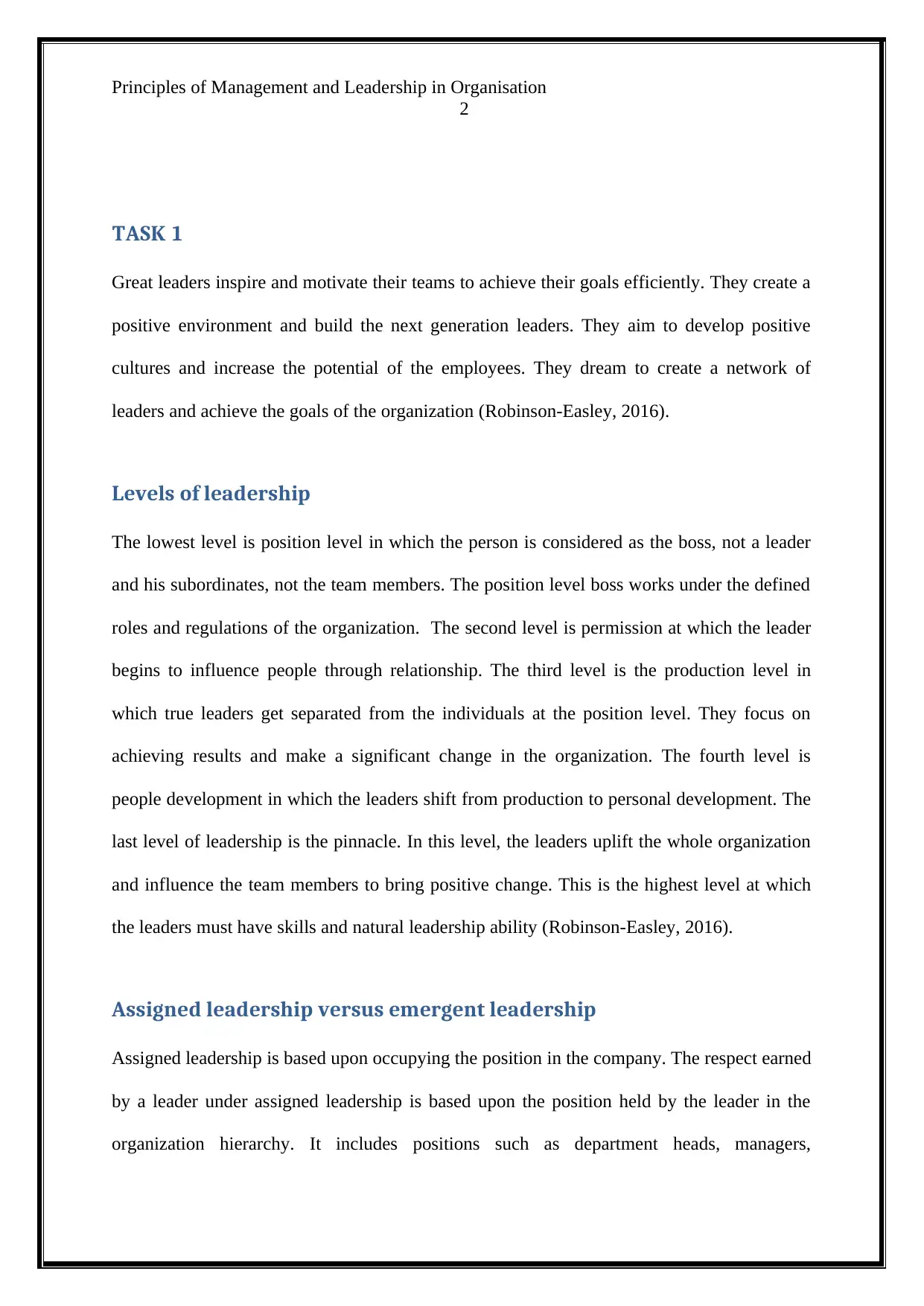
Principles of Management and Leadership in Organisation
2
TASK 1
Great leaders inspire and motivate their teams to achieve their goals efficiently. They create a
positive environment and build the next generation leaders. They aim to develop positive
cultures and increase the potential of the employees. They dream to create a network of
leaders and achieve the goals of the organization (Robinson-Easley, 2016).
Levels of leadership
The lowest level is position level in which the person is considered as the boss, not a leader
and his subordinates, not the team members. The position level boss works under the defined
roles and regulations of the organization. The second level is permission at which the leader
begins to influence people through relationship. The third level is the production level in
which true leaders get separated from the individuals at the position level. They focus on
achieving results and make a significant change in the organization. The fourth level is
people development in which the leaders shift from production to personal development. The
last level of leadership is the pinnacle. In this level, the leaders uplift the whole organization
and influence the team members to bring positive change. This is the highest level at which
the leaders must have skills and natural leadership ability (Robinson-Easley, 2016).
Assigned leadership versus emergent leadership
Assigned leadership is based upon occupying the position in the company. The respect earned
by a leader under assigned leadership is based upon the position held by the leader in the
organization hierarchy. It includes positions such as department heads, managers,
2
TASK 1
Great leaders inspire and motivate their teams to achieve their goals efficiently. They create a
positive environment and build the next generation leaders. They aim to develop positive
cultures and increase the potential of the employees. They dream to create a network of
leaders and achieve the goals of the organization (Robinson-Easley, 2016).
Levels of leadership
The lowest level is position level in which the person is considered as the boss, not a leader
and his subordinates, not the team members. The position level boss works under the defined
roles and regulations of the organization. The second level is permission at which the leader
begins to influence people through relationship. The third level is the production level in
which true leaders get separated from the individuals at the position level. They focus on
achieving results and make a significant change in the organization. The fourth level is
people development in which the leaders shift from production to personal development. The
last level of leadership is the pinnacle. In this level, the leaders uplift the whole organization
and influence the team members to bring positive change. This is the highest level at which
the leaders must have skills and natural leadership ability (Robinson-Easley, 2016).
Assigned leadership versus emergent leadership
Assigned leadership is based upon occupying the position in the company. The respect earned
by a leader under assigned leadership is based upon the position held by the leader in the
organization hierarchy. It includes positions such as department heads, managers,
⊘ This is a preview!⊘
Do you want full access?
Subscribe today to unlock all pages.

Trusted by 1+ million students worldwide
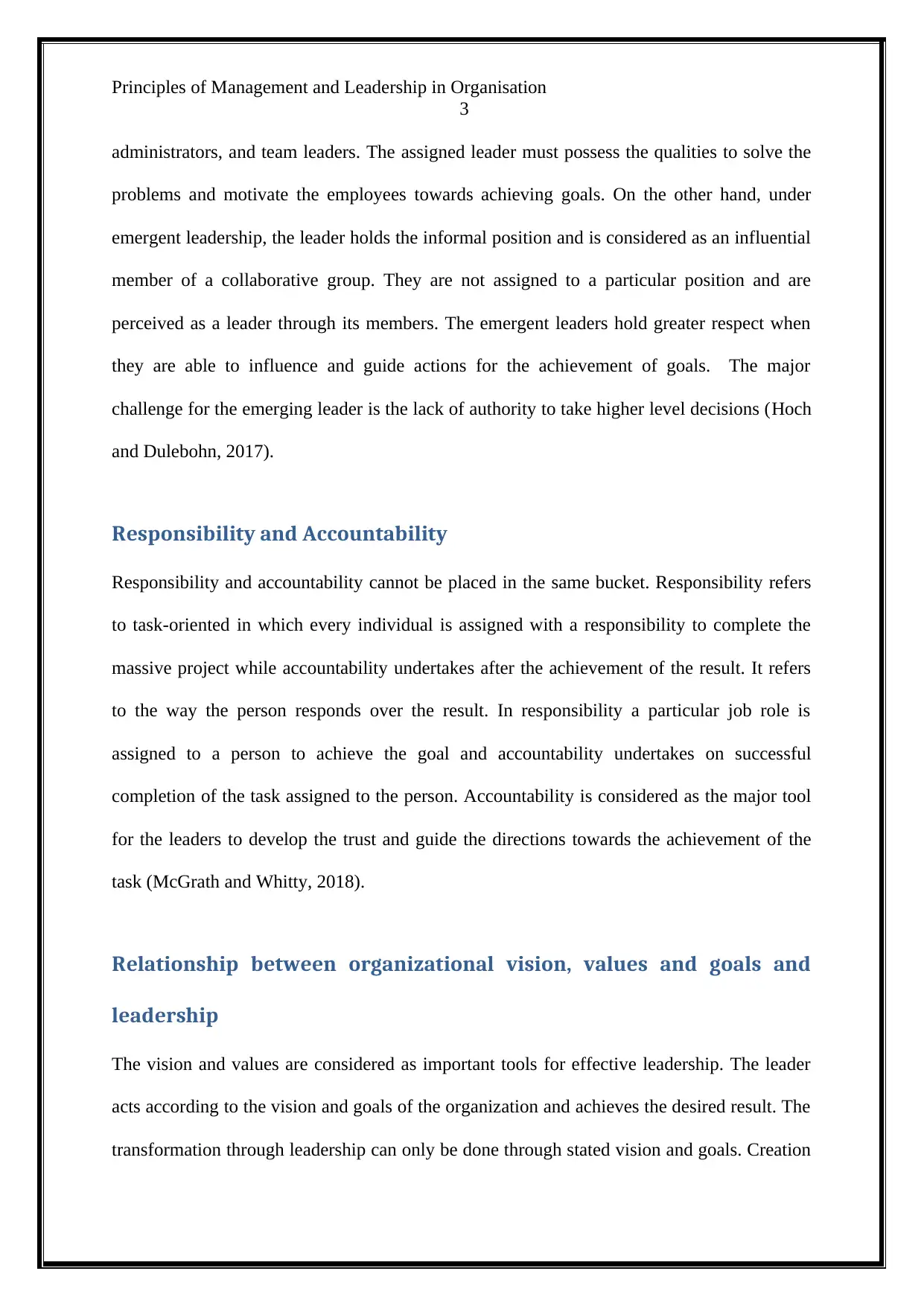
Principles of Management and Leadership in Organisation
3
administrators, and team leaders. The assigned leader must possess the qualities to solve the
problems and motivate the employees towards achieving goals. On the other hand, under
emergent leadership, the leader holds the informal position and is considered as an influential
member of a collaborative group. They are not assigned to a particular position and are
perceived as a leader through its members. The emergent leaders hold greater respect when
they are able to influence and guide actions for the achievement of goals. The major
challenge for the emerging leader is the lack of authority to take higher level decisions (Hoch
and Dulebohn, 2017).
Responsibility and Accountability
Responsibility and accountability cannot be placed in the same bucket. Responsibility refers
to task-oriented in which every individual is assigned with a responsibility to complete the
massive project while accountability undertakes after the achievement of the result. It refers
to the way the person responds over the result. In responsibility a particular job role is
assigned to a person to achieve the goal and accountability undertakes on successful
completion of the task assigned to the person. Accountability is considered as the major tool
for the leaders to develop the trust and guide the directions towards the achievement of the
task (McGrath and Whitty, 2018).
Relationship between organizational vision, values and goals and
leadership
The vision and values are considered as important tools for effective leadership. The leader
acts according to the vision and goals of the organization and achieves the desired result. The
transformation through leadership can only be done through stated vision and goals. Creation
3
administrators, and team leaders. The assigned leader must possess the qualities to solve the
problems and motivate the employees towards achieving goals. On the other hand, under
emergent leadership, the leader holds the informal position and is considered as an influential
member of a collaborative group. They are not assigned to a particular position and are
perceived as a leader through its members. The emergent leaders hold greater respect when
they are able to influence and guide actions for the achievement of goals. The major
challenge for the emerging leader is the lack of authority to take higher level decisions (Hoch
and Dulebohn, 2017).
Responsibility and Accountability
Responsibility and accountability cannot be placed in the same bucket. Responsibility refers
to task-oriented in which every individual is assigned with a responsibility to complete the
massive project while accountability undertakes after the achievement of the result. It refers
to the way the person responds over the result. In responsibility a particular job role is
assigned to a person to achieve the goal and accountability undertakes on successful
completion of the task assigned to the person. Accountability is considered as the major tool
for the leaders to develop the trust and guide the directions towards the achievement of the
task (McGrath and Whitty, 2018).
Relationship between organizational vision, values and goals and
leadership
The vision and values are considered as important tools for effective leadership. The leader
acts according to the vision and goals of the organization and achieves the desired result. The
transformation through leadership can only be done through stated vision and goals. Creation
Paraphrase This Document
Need a fresh take? Get an instant paraphrase of this document with our AI Paraphraser
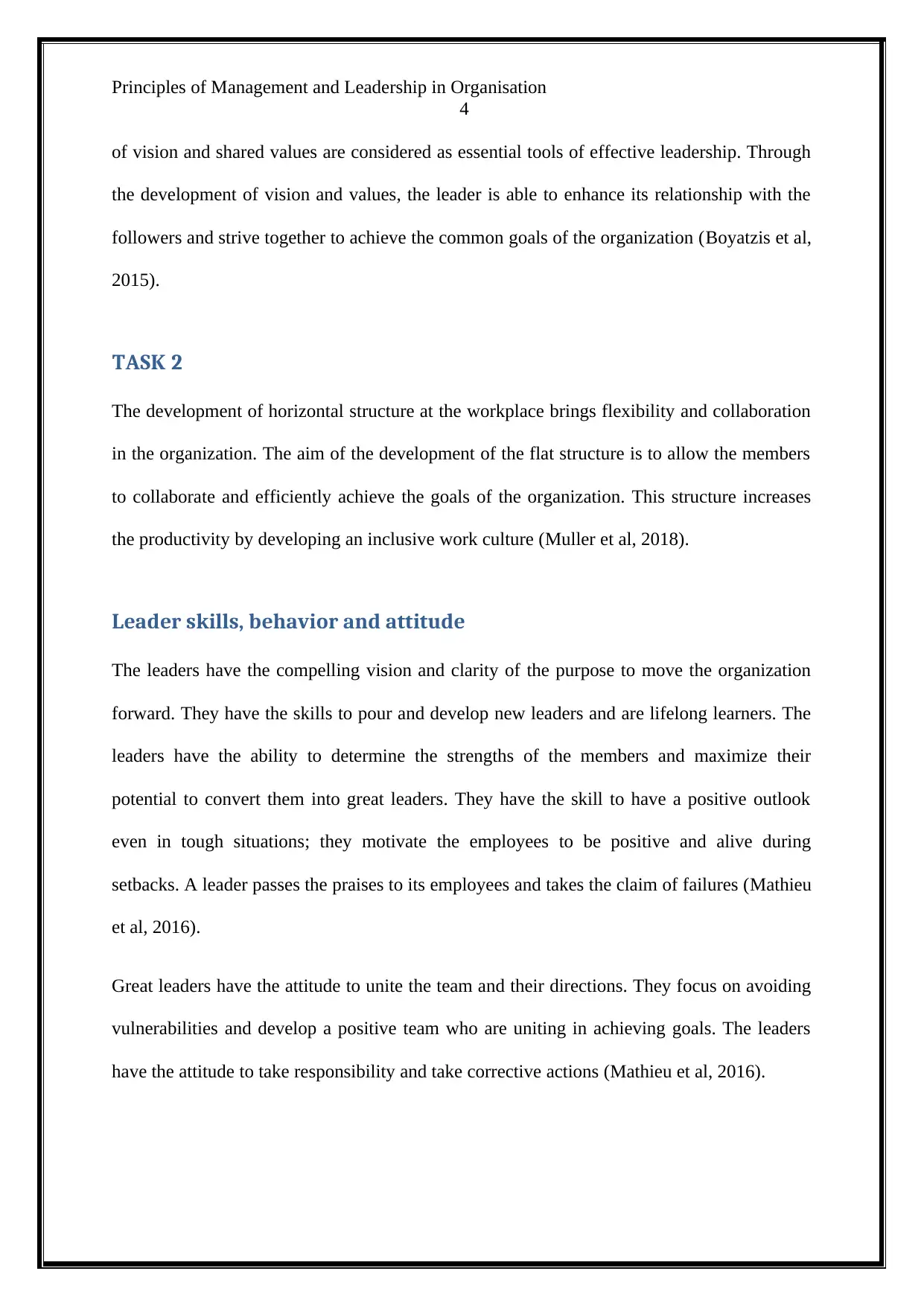
Principles of Management and Leadership in Organisation
4
of vision and shared values are considered as essential tools of effective leadership. Through
the development of vision and values, the leader is able to enhance its relationship with the
followers and strive together to achieve the common goals of the organization (Boyatzis et al,
2015).
TASK 2
The development of horizontal structure at the workplace brings flexibility and collaboration
in the organization. The aim of the development of the flat structure is to allow the members
to collaborate and efficiently achieve the goals of the organization. This structure increases
the productivity by developing an inclusive work culture (Muller et al, 2018).
Leader skills, behavior and attitude
The leaders have the compelling vision and clarity of the purpose to move the organization
forward. They have the skills to pour and develop new leaders and are lifelong learners. The
leaders have the ability to determine the strengths of the members and maximize their
potential to convert them into great leaders. They have the skill to have a positive outlook
even in tough situations; they motivate the employees to be positive and alive during
setbacks. A leader passes the praises to its employees and takes the claim of failures (Mathieu
et al, 2016).
Great leaders have the attitude to unite the team and their directions. They focus on avoiding
vulnerabilities and develop a positive team who are uniting in achieving goals. The leaders
have the attitude to take responsibility and take corrective actions (Mathieu et al, 2016).
4
of vision and shared values are considered as essential tools of effective leadership. Through
the development of vision and values, the leader is able to enhance its relationship with the
followers and strive together to achieve the common goals of the organization (Boyatzis et al,
2015).
TASK 2
The development of horizontal structure at the workplace brings flexibility and collaboration
in the organization. The aim of the development of the flat structure is to allow the members
to collaborate and efficiently achieve the goals of the organization. This structure increases
the productivity by developing an inclusive work culture (Muller et al, 2018).
Leader skills, behavior and attitude
The leaders have the compelling vision and clarity of the purpose to move the organization
forward. They have the skills to pour and develop new leaders and are lifelong learners. The
leaders have the ability to determine the strengths of the members and maximize their
potential to convert them into great leaders. They have the skill to have a positive outlook
even in tough situations; they motivate the employees to be positive and alive during
setbacks. A leader passes the praises to its employees and takes the claim of failures (Mathieu
et al, 2016).
Great leaders have the attitude to unite the team and their directions. They focus on avoiding
vulnerabilities and develop a positive team who are uniting in achieving goals. The leaders
have the attitude to take responsibility and take corrective actions (Mathieu et al, 2016).
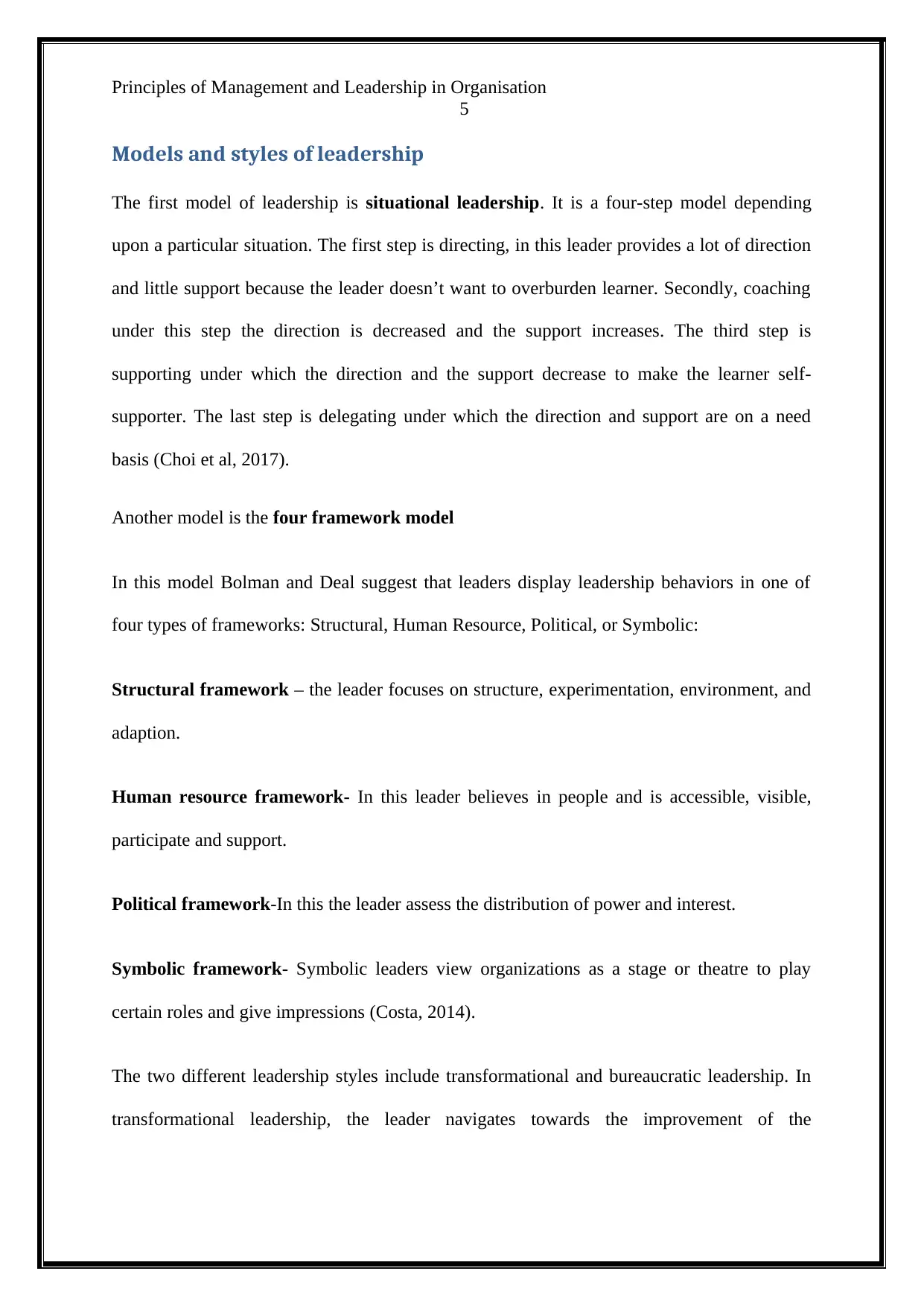
Principles of Management and Leadership in Organisation
5
Models and styles of leadership
The first model of leadership is situational leadership. It is a four-step model depending
upon a particular situation. The first step is directing, in this leader provides a lot of direction
and little support because the leader doesn’t want to overburden learner. Secondly, coaching
under this step the direction is decreased and the support increases. The third step is
supporting under which the direction and the support decrease to make the learner self-
supporter. The last step is delegating under which the direction and support are on a need
basis (Choi et al, 2017).
Another model is the four framework model
In this model Bolman and Deal suggest that leaders display leadership behaviors in one of
four types of frameworks: Structural, Human Resource, Political, or Symbolic:
Structural framework – the leader focuses on structure, experimentation, environment, and
adaption.
Human resource framework- In this leader believes in people and is accessible, visible,
participate and support.
Political framework-In this the leader assess the distribution of power and interest.
Symbolic framework- Symbolic leaders view organizations as a stage or theatre to play
certain roles and give impressions (Costa, 2014).
The two different leadership styles include transformational and bureaucratic leadership. In
transformational leadership, the leader navigates towards the improvement of the
5
Models and styles of leadership
The first model of leadership is situational leadership. It is a four-step model depending
upon a particular situation. The first step is directing, in this leader provides a lot of direction
and little support because the leader doesn’t want to overburden learner. Secondly, coaching
under this step the direction is decreased and the support increases. The third step is
supporting under which the direction and the support decrease to make the learner self-
supporter. The last step is delegating under which the direction and support are on a need
basis (Choi et al, 2017).
Another model is the four framework model
In this model Bolman and Deal suggest that leaders display leadership behaviors in one of
four types of frameworks: Structural, Human Resource, Political, or Symbolic:
Structural framework – the leader focuses on structure, experimentation, environment, and
adaption.
Human resource framework- In this leader believes in people and is accessible, visible,
participate and support.
Political framework-In this the leader assess the distribution of power and interest.
Symbolic framework- Symbolic leaders view organizations as a stage or theatre to play
certain roles and give impressions (Costa, 2014).
The two different leadership styles include transformational and bureaucratic leadership. In
transformational leadership, the leader navigates towards the improvement of the
⊘ This is a preview!⊘
Do you want full access?
Subscribe today to unlock all pages.

Trusted by 1+ million students worldwide
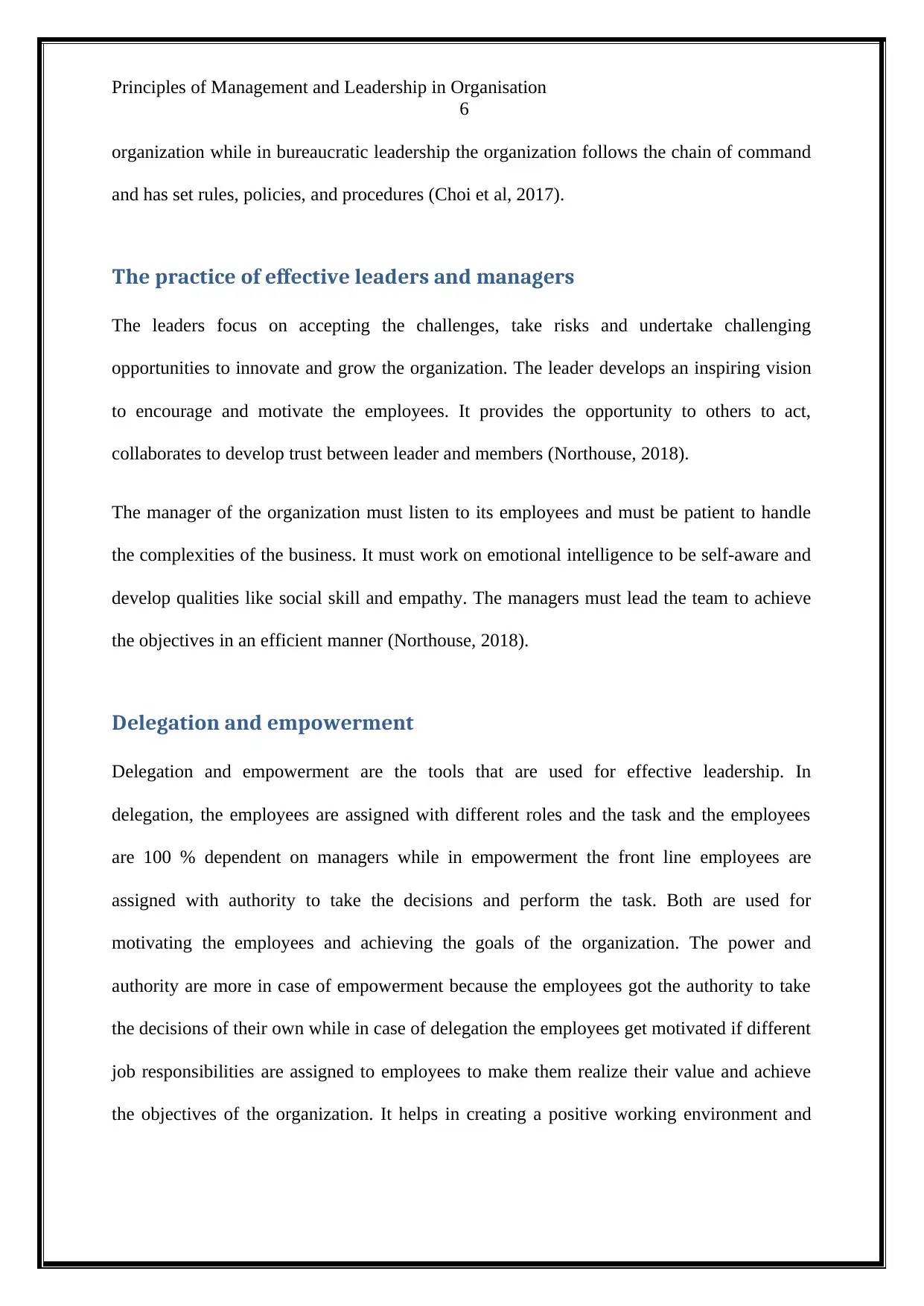
Principles of Management and Leadership in Organisation
6
organization while in bureaucratic leadership the organization follows the chain of command
and has set rules, policies, and procedures (Choi et al, 2017).
The practice of effective leaders and managers
The leaders focus on accepting the challenges, take risks and undertake challenging
opportunities to innovate and grow the organization. The leader develops an inspiring vision
to encourage and motivate the employees. It provides the opportunity to others to act,
collaborates to develop trust between leader and members (Northouse, 2018).
The manager of the organization must listen to its employees and must be patient to handle
the complexities of the business. It must work on emotional intelligence to be self-aware and
develop qualities like social skill and empathy. The managers must lead the team to achieve
the objectives in an efficient manner (Northouse, 2018).
Delegation and empowerment
Delegation and empowerment are the tools that are used for effective leadership. In
delegation, the employees are assigned with different roles and the task and the employees
are 100 % dependent on managers while in empowerment the front line employees are
assigned with authority to take the decisions and perform the task. Both are used for
motivating the employees and achieving the goals of the organization. The power and
authority are more in case of empowerment because the employees got the authority to take
the decisions of their own while in case of delegation the employees get motivated if different
job responsibilities are assigned to employees to make them realize their value and achieve
the objectives of the organization. It helps in creating a positive working environment and
6
organization while in bureaucratic leadership the organization follows the chain of command
and has set rules, policies, and procedures (Choi et al, 2017).
The practice of effective leaders and managers
The leaders focus on accepting the challenges, take risks and undertake challenging
opportunities to innovate and grow the organization. The leader develops an inspiring vision
to encourage and motivate the employees. It provides the opportunity to others to act,
collaborates to develop trust between leader and members (Northouse, 2018).
The manager of the organization must listen to its employees and must be patient to handle
the complexities of the business. It must work on emotional intelligence to be self-aware and
develop qualities like social skill and empathy. The managers must lead the team to achieve
the objectives in an efficient manner (Northouse, 2018).
Delegation and empowerment
Delegation and empowerment are the tools that are used for effective leadership. In
delegation, the employees are assigned with different roles and the task and the employees
are 100 % dependent on managers while in empowerment the front line employees are
assigned with authority to take the decisions and perform the task. Both are used for
motivating the employees and achieving the goals of the organization. The power and
authority are more in case of empowerment because the employees got the authority to take
the decisions of their own while in case of delegation the employees get motivated if different
job responsibilities are assigned to employees to make them realize their value and achieve
the objectives of the organization. It helps in creating a positive working environment and
Paraphrase This Document
Need a fresh take? Get an instant paraphrase of this document with our AI Paraphraser
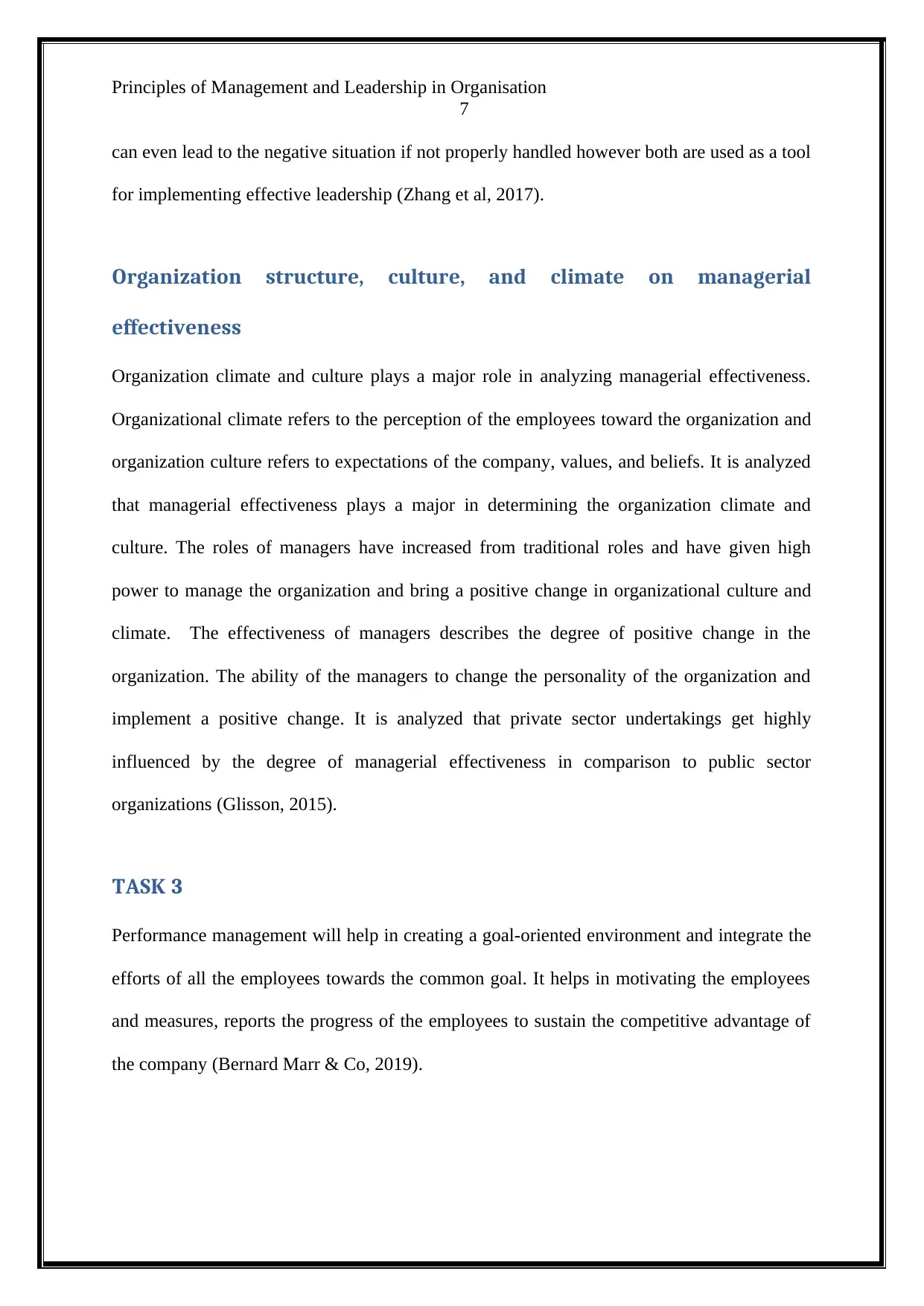
Principles of Management and Leadership in Organisation
7
can even lead to the negative situation if not properly handled however both are used as a tool
for implementing effective leadership (Zhang et al, 2017).
Organization structure, culture, and climate on managerial
effectiveness
Organization climate and culture plays a major role in analyzing managerial effectiveness.
Organizational climate refers to the perception of the employees toward the organization and
organization culture refers to expectations of the company, values, and beliefs. It is analyzed
that managerial effectiveness plays a major in determining the organization climate and
culture. The roles of managers have increased from traditional roles and have given high
power to manage the organization and bring a positive change in organizational culture and
climate. The effectiveness of managers describes the degree of positive change in the
organization. The ability of the managers to change the personality of the organization and
implement a positive change. It is analyzed that private sector undertakings get highly
influenced by the degree of managerial effectiveness in comparison to public sector
organizations (Glisson, 2015).
TASK 3
Performance management will help in creating a goal-oriented environment and integrate the
efforts of all the employees towards the common goal. It helps in motivating the employees
and measures, reports the progress of the employees to sustain the competitive advantage of
the company (Bernard Marr & Co, 2019).
7
can even lead to the negative situation if not properly handled however both are used as a tool
for implementing effective leadership (Zhang et al, 2017).
Organization structure, culture, and climate on managerial
effectiveness
Organization climate and culture plays a major role in analyzing managerial effectiveness.
Organizational climate refers to the perception of the employees toward the organization and
organization culture refers to expectations of the company, values, and beliefs. It is analyzed
that managerial effectiveness plays a major in determining the organization climate and
culture. The roles of managers have increased from traditional roles and have given high
power to manage the organization and bring a positive change in organizational culture and
climate. The effectiveness of managers describes the degree of positive change in the
organization. The ability of the managers to change the personality of the organization and
implement a positive change. It is analyzed that private sector undertakings get highly
influenced by the degree of managerial effectiveness in comparison to public sector
organizations (Glisson, 2015).
TASK 3
Performance management will help in creating a goal-oriented environment and integrate the
efforts of all the employees towards the common goal. It helps in motivating the employees
and measures, reports the progress of the employees to sustain the competitive advantage of
the company (Bernard Marr & Co, 2019).
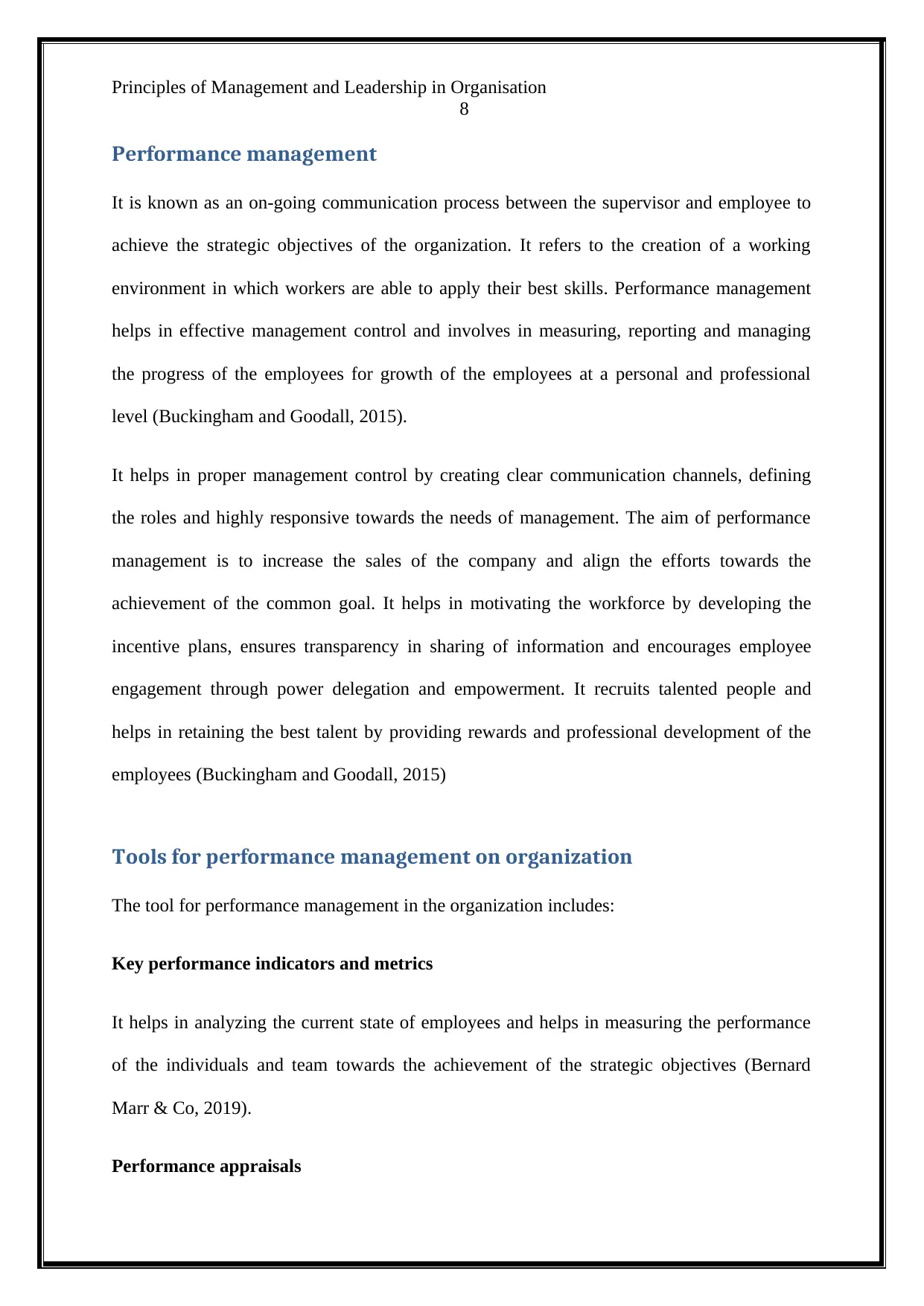
Principles of Management and Leadership in Organisation
8
Performance management
It is known as an on-going communication process between the supervisor and employee to
achieve the strategic objectives of the organization. It refers to the creation of a working
environment in which workers are able to apply their best skills. Performance management
helps in effective management control and involves in measuring, reporting and managing
the progress of the employees for growth of the employees at a personal and professional
level (Buckingham and Goodall, 2015).
It helps in proper management control by creating clear communication channels, defining
the roles and highly responsive towards the needs of management. The aim of performance
management is to increase the sales of the company and align the efforts towards the
achievement of the common goal. It helps in motivating the workforce by developing the
incentive plans, ensures transparency in sharing of information and encourages employee
engagement through power delegation and empowerment. It recruits talented people and
helps in retaining the best talent by providing rewards and professional development of the
employees (Buckingham and Goodall, 2015)
Tools for performance management on organization
The tool for performance management in the organization includes:
Key performance indicators and metrics
It helps in analyzing the current state of employees and helps in measuring the performance
of the individuals and team towards the achievement of the strategic objectives (Bernard
Marr & Co, 2019).
Performance appraisals
8
Performance management
It is known as an on-going communication process between the supervisor and employee to
achieve the strategic objectives of the organization. It refers to the creation of a working
environment in which workers are able to apply their best skills. Performance management
helps in effective management control and involves in measuring, reporting and managing
the progress of the employees for growth of the employees at a personal and professional
level (Buckingham and Goodall, 2015).
It helps in proper management control by creating clear communication channels, defining
the roles and highly responsive towards the needs of management. The aim of performance
management is to increase the sales of the company and align the efforts towards the
achievement of the common goal. It helps in motivating the workforce by developing the
incentive plans, ensures transparency in sharing of information and encourages employee
engagement through power delegation and empowerment. It recruits talented people and
helps in retaining the best talent by providing rewards and professional development of the
employees (Buckingham and Goodall, 2015)
Tools for performance management on organization
The tool for performance management in the organization includes:
Key performance indicators and metrics
It helps in analyzing the current state of employees and helps in measuring the performance
of the individuals and team towards the achievement of the strategic objectives (Bernard
Marr & Co, 2019).
Performance appraisals
⊘ This is a preview!⊘
Do you want full access?
Subscribe today to unlock all pages.

Trusted by 1+ million students worldwide
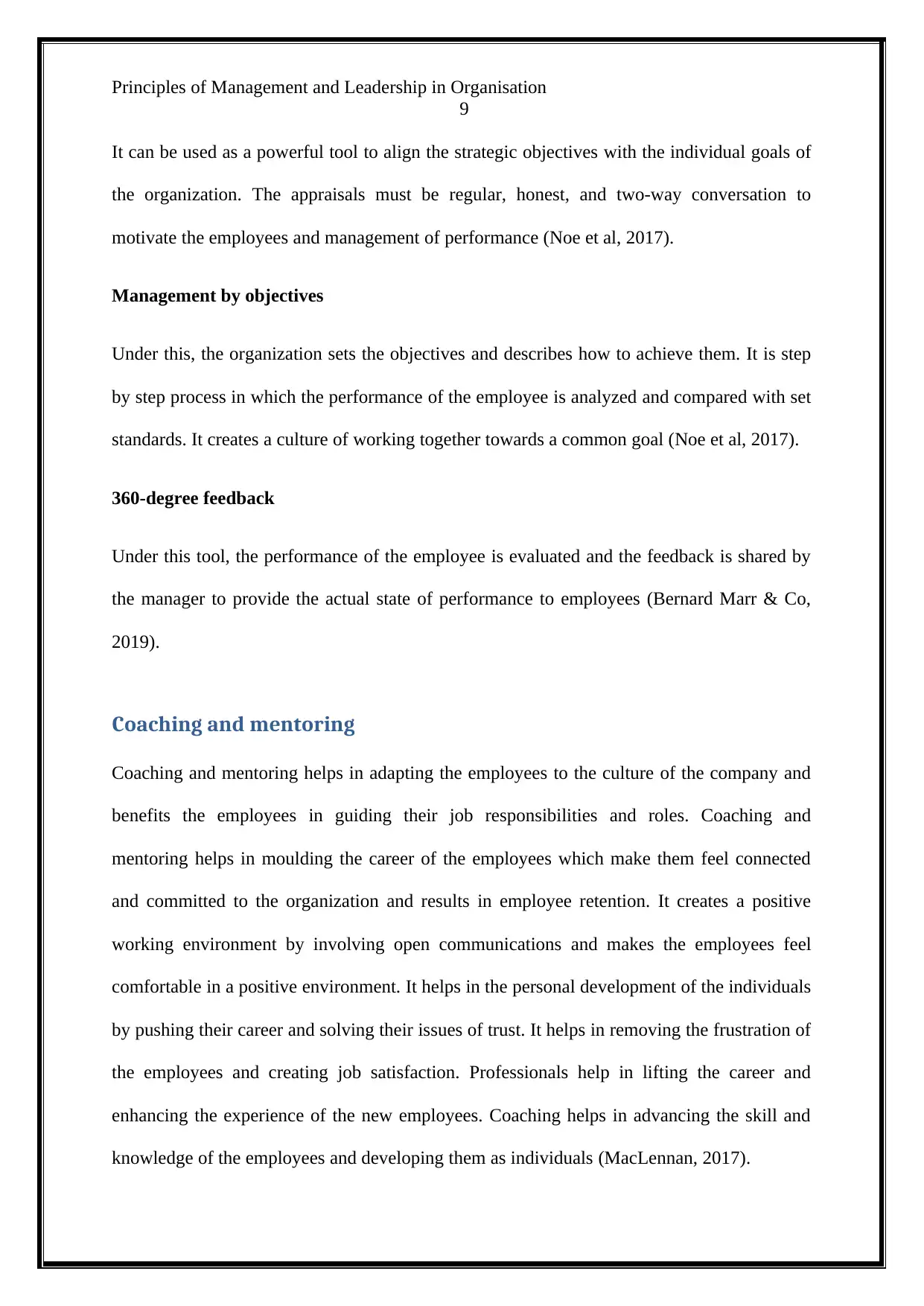
Principles of Management and Leadership in Organisation
9
It can be used as a powerful tool to align the strategic objectives with the individual goals of
the organization. The appraisals must be regular, honest, and two-way conversation to
motivate the employees and management of performance (Noe et al, 2017).
Management by objectives
Under this, the organization sets the objectives and describes how to achieve them. It is step
by step process in which the performance of the employee is analyzed and compared with set
standards. It creates a culture of working together towards a common goal (Noe et al, 2017).
360-degree feedback
Under this tool, the performance of the employee is evaluated and the feedback is shared by
the manager to provide the actual state of performance to employees (Bernard Marr & Co,
2019).
Coaching and mentoring
Coaching and mentoring helps in adapting the employees to the culture of the company and
benefits the employees in guiding their job responsibilities and roles. Coaching and
mentoring helps in moulding the career of the employees which make them feel connected
and committed to the organization and results in employee retention. It creates a positive
working environment by involving open communications and makes the employees feel
comfortable in a positive environment. It helps in the personal development of the individuals
by pushing their career and solving their issues of trust. It helps in removing the frustration of
the employees and creating job satisfaction. Professionals help in lifting the career and
enhancing the experience of the new employees. Coaching helps in advancing the skill and
knowledge of the employees and developing them as individuals (MacLennan, 2017).
9
It can be used as a powerful tool to align the strategic objectives with the individual goals of
the organization. The appraisals must be regular, honest, and two-way conversation to
motivate the employees and management of performance (Noe et al, 2017).
Management by objectives
Under this, the organization sets the objectives and describes how to achieve them. It is step
by step process in which the performance of the employee is analyzed and compared with set
standards. It creates a culture of working together towards a common goal (Noe et al, 2017).
360-degree feedback
Under this tool, the performance of the employee is evaluated and the feedback is shared by
the manager to provide the actual state of performance to employees (Bernard Marr & Co,
2019).
Coaching and mentoring
Coaching and mentoring helps in adapting the employees to the culture of the company and
benefits the employees in guiding their job responsibilities and roles. Coaching and
mentoring helps in moulding the career of the employees which make them feel connected
and committed to the organization and results in employee retention. It creates a positive
working environment by involving open communications and makes the employees feel
comfortable in a positive environment. It helps in the personal development of the individuals
by pushing their career and solving their issues of trust. It helps in removing the frustration of
the employees and creating job satisfaction. Professionals help in lifting the career and
enhancing the experience of the new employees. Coaching helps in advancing the skill and
knowledge of the employees and developing them as individuals (MacLennan, 2017).
Paraphrase This Document
Need a fresh take? Get an instant paraphrase of this document with our AI Paraphraser
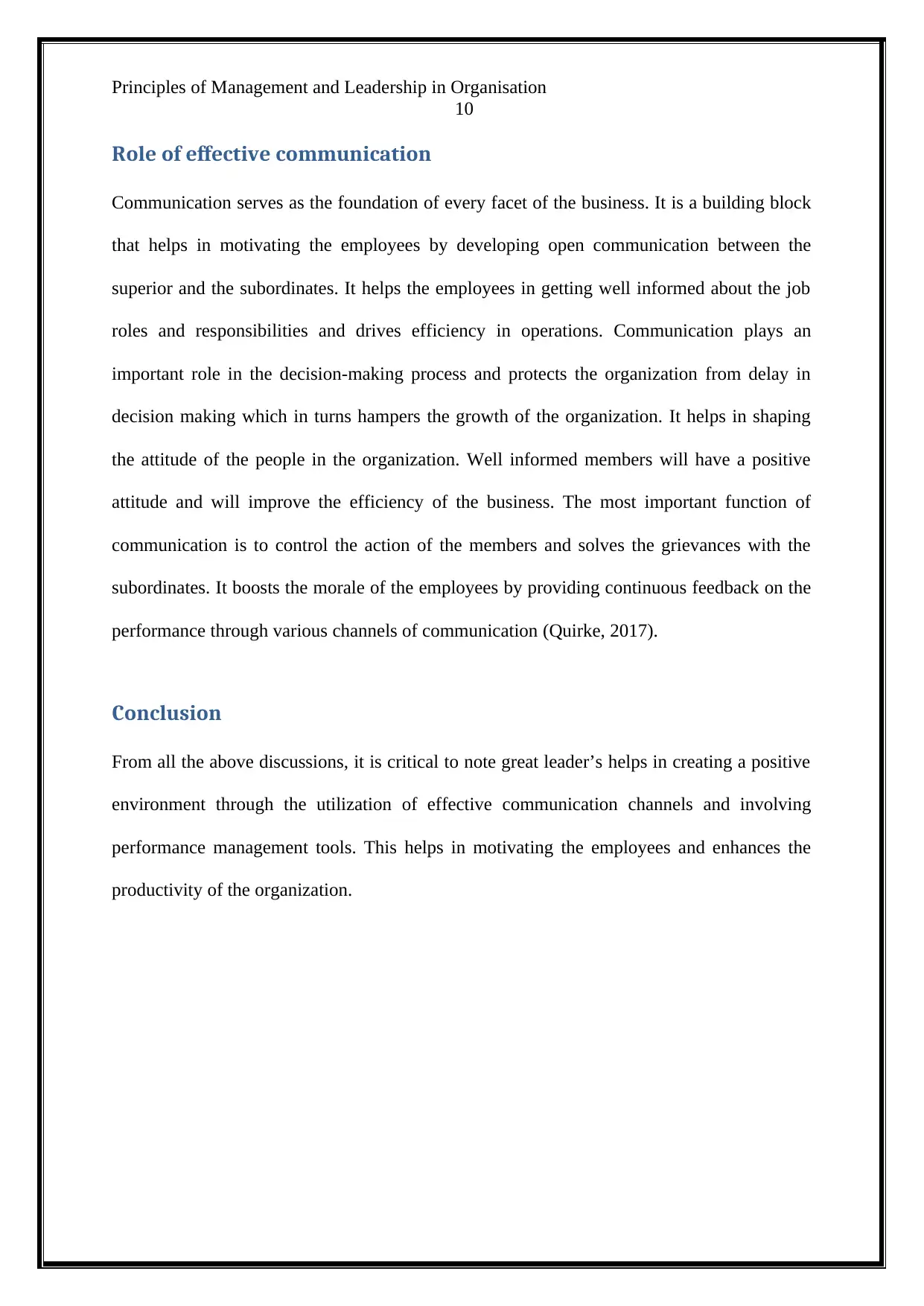
Principles of Management and Leadership in Organisation
10
Role of effective communication
Communication serves as the foundation of every facet of the business. It is a building block
that helps in motivating the employees by developing open communication between the
superior and the subordinates. It helps the employees in getting well informed about the job
roles and responsibilities and drives efficiency in operations. Communication plays an
important role in the decision-making process and protects the organization from delay in
decision making which in turns hampers the growth of the organization. It helps in shaping
the attitude of the people in the organization. Well informed members will have a positive
attitude and will improve the efficiency of the business. The most important function of
communication is to control the action of the members and solves the grievances with the
subordinates. It boosts the morale of the employees by providing continuous feedback on the
performance through various channels of communication (Quirke, 2017).
Conclusion
From all the above discussions, it is critical to note great leader’s helps in creating a positive
environment through the utilization of effective communication channels and involving
performance management tools. This helps in motivating the employees and enhances the
productivity of the organization.
10
Role of effective communication
Communication serves as the foundation of every facet of the business. It is a building block
that helps in motivating the employees by developing open communication between the
superior and the subordinates. It helps the employees in getting well informed about the job
roles and responsibilities and drives efficiency in operations. Communication plays an
important role in the decision-making process and protects the organization from delay in
decision making which in turns hampers the growth of the organization. It helps in shaping
the attitude of the people in the organization. Well informed members will have a positive
attitude and will improve the efficiency of the business. The most important function of
communication is to control the action of the members and solves the grievances with the
subordinates. It boosts the morale of the employees by providing continuous feedback on the
performance through various channels of communication (Quirke, 2017).
Conclusion
From all the above discussions, it is critical to note great leader’s helps in creating a positive
environment through the utilization of effective communication channels and involving
performance management tools. This helps in motivating the employees and enhances the
productivity of the organization.
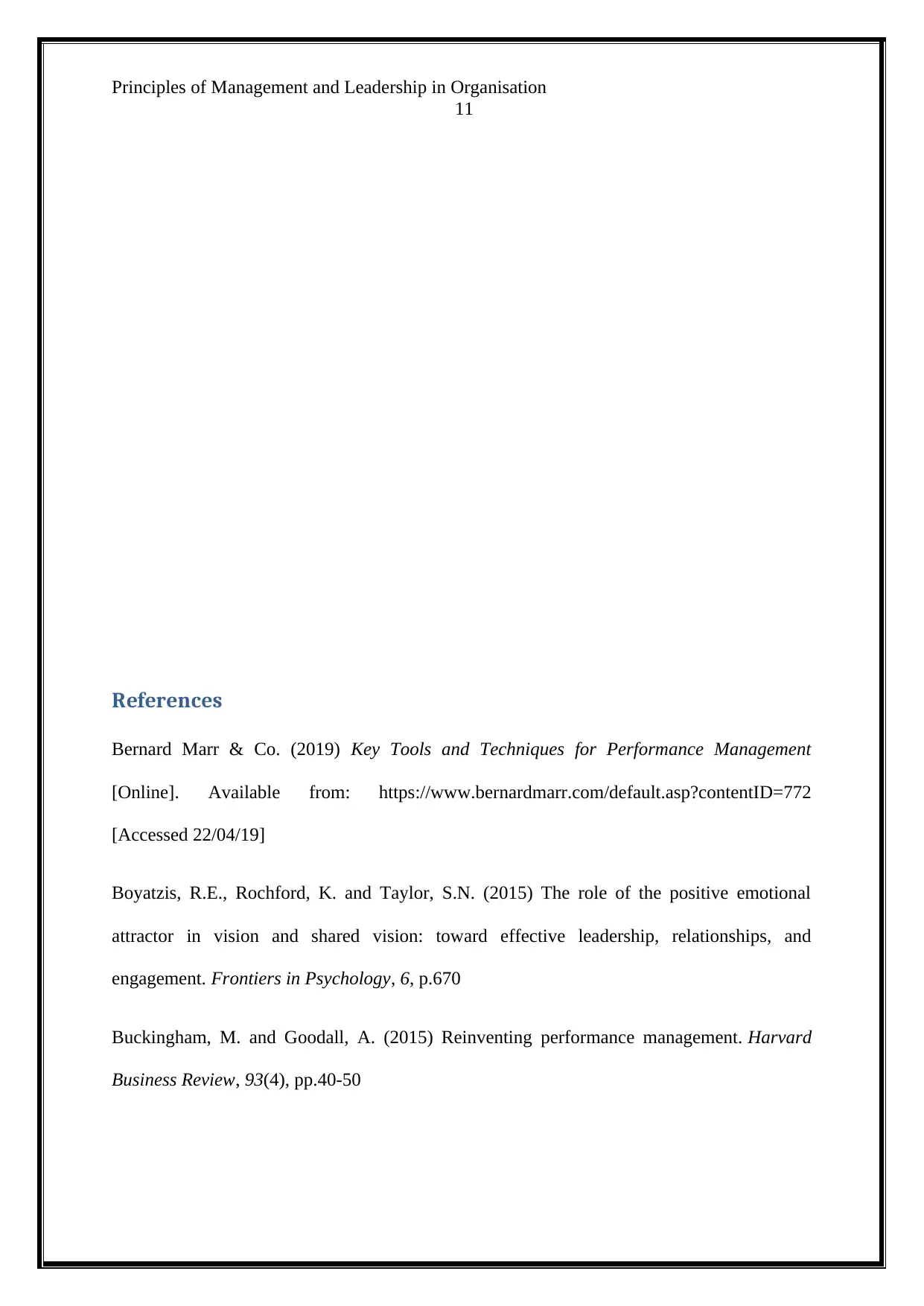
Principles of Management and Leadership in Organisation
11
References
Bernard Marr & Co. (2019) Key Tools and Techniques for Performance Management
[Online]. Available from: https://www.bernardmarr.com/default.asp?contentID=772
[Accessed 22/04/19]
Boyatzis, R.E., Rochford, K. and Taylor, S.N. (2015) The role of the positive emotional
attractor in vision and shared vision: toward effective leadership, relationships, and
engagement. Frontiers in Psychology, 6, p.670
Buckingham, M. and Goodall, A. (2015) Reinventing performance management. Harvard
Business Review, 93(4), pp.40-50
11
References
Bernard Marr & Co. (2019) Key Tools and Techniques for Performance Management
[Online]. Available from: https://www.bernardmarr.com/default.asp?contentID=772
[Accessed 22/04/19]
Boyatzis, R.E., Rochford, K. and Taylor, S.N. (2015) The role of the positive emotional
attractor in vision and shared vision: toward effective leadership, relationships, and
engagement. Frontiers in Psychology, 6, p.670
Buckingham, M. and Goodall, A. (2015) Reinventing performance management. Harvard
Business Review, 93(4), pp.40-50
⊘ This is a preview!⊘
Do you want full access?
Subscribe today to unlock all pages.

Trusted by 1+ million students worldwide
1 out of 14
Related Documents
Your All-in-One AI-Powered Toolkit for Academic Success.
+13062052269
info@desklib.com
Available 24*7 on WhatsApp / Email
![[object Object]](/_next/static/media/star-bottom.7253800d.svg)
Unlock your academic potential
Copyright © 2020–2025 A2Z Services. All Rights Reserved. Developed and managed by ZUCOL.





